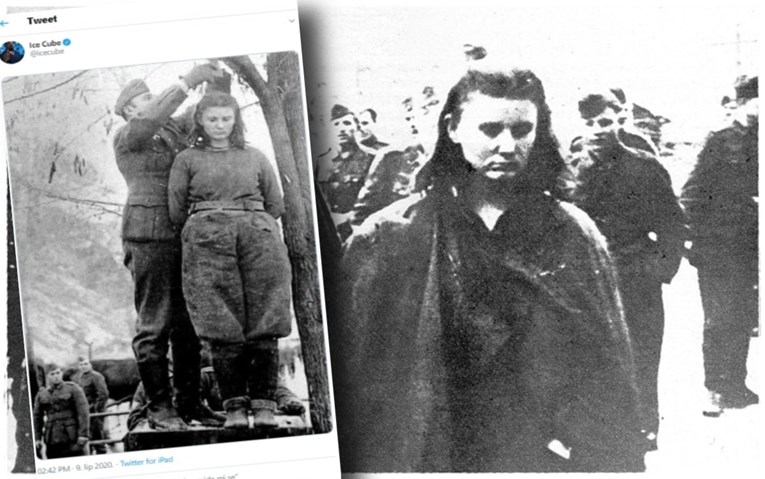Ice Cube posted a photo of the hanging of Lepa Radic, do you know her story?

AMERICAN rapper Ice Cube posted a photo of the hanging of Lepa Radic, a partisan who was executed by the Germans when she was only 17. She was proclaimed a national hero in 1951.
Ice Cube did not add a description to the photo, but his followers immediately rushed to explain who the girl in the photo was and what her story was in the comments. The rapper has recently been posting historical photos, with some of them being related to the protests in the USA.
In collaboration with the Yugopapir, we bring you the story of the life and death of Lepa Radic, which was originally published in 1968.
March 1968: During the fight for the liberation of Zagreb, a photographic film showing the hanging of a partisan girl was found in the purse of a German soldier who died in Ilica.
However, no one knew who this heroic girl was. Despite a persistent search, her name remained unknown. The impressive photograph of the tragic death of a defiant girl was kept in the Museum of the Revolution in Mostar after the war.
One day, a soldier stopped by the museum. "That is my uncle's sister!" he exclaimed, almost in disbelief. That is how the name of the partisan Lepa Radic from the poor village of Bistrica near Kozar, who was hanged by the Germans in 1943, became known.
What was she like?
Memories from an old photo album
Dragica Radulovic, a teacher at a school in Bosanska Gradiska, talked about her memories while flipping through a yellowed student photo album containing a few old photos: "Of course I remember Lepa. She was my student. She always looked cheerful and good-spirited. She loved poetry... "
This elderly teacher pulled out a photo of twelve smiling girls in colorful folk costumes.
"These are her friends. Lepa is unfortunately not in this photo. I remember how much she wanted to see the sea. But she did not go on our school trip because it cost a lot of money. She did not want to spend her father's hard-earned money."
A family of heroes
As a student in Bosanska Gradiska, Lepa read banned books she would get from her uncle Vlade, an electrician, and a communist. Then the war came. Her father Sveto, uncles Vlade and Voja, and aunt Jovanka joined the partisans.
On her sixteenth birthday, Lepa went to battle with her sister Dara, who was only a year older. She was the youngest nurse in the infirmary of the Second Krajina Detachment. In July 1942, when the great battle for Kozara began, Lepa passed through the enemy line with one of the battalions and arrived at Podgrmec. Her father Sveto, and uncle Vlade were killed in that battle, and her only brother Milan, still a child, was taken to Jasenovac, and he never returned from there.
In Podgrmec, as a member of the Municipal Committee of the CPY for Srednji Dubovik near Bosanska Krupa, she gathered young people and women during the day, and at night, she fought at enemy strongholds. A letter to her sister Dara from those difficult days has been preserved: "I would like to see you because you're the only one I have left, but my job does not allow it. Whenever I am free, I sit in my small room and think about all of us, about our brother Milan, who is now rotting somewhere in Jasenovac ..."
Fight, people!
During the period of fierce clashes under Grmec in January 1943, Lepa was a member of the staff in charge of the evacuation of civilians and the wounded, as well as food and livestock from the area attacked by the enemy. On one fateful February night, as the Fifth and Second Krajina Detachments were breaking the enemy line across Ravni Dol, Lepa was walking through deep snow behind the partisan brigades with more than a hundred women, children, and elderly people.
However, fast German columns reached their refuge in the mountains. She fired all the ammunition she had at the Germans, but it was not even enough to protect her, let alone the helpless children and women. She charged at the enemy and shouted: "Fight, people! Don't let yourself fall into the hands of the wicked! Let them kill me, my death will be avenged!"
Just a few days later, she walked in silence towards a table under an acacia tree near the train station in Bosanska Krupa. When she stood under the gallows, she defiantly exclaimed, "Long live the partisans! Long live the Red Army!" but the noose interrupted her last word.
This happened at the end of February 1943. That is the story of how Lepa Radic died before she turned eighteen. She was buried there under the acacia tree, where a modest monument stands today.
Written by: Dragoje Lukic (Ilustrovana, 1968)



 Facebook
Facebook
 Google
Google